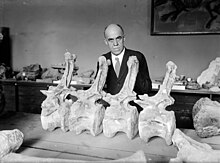Charles W. Gilmore
Charles Whitney Gilmore (born March 11, 1874 in Pavilion , New York , † September 27, 1945 in New York City ) was an American vertebrate paleontologist who studied dinosaurs .

Life
Gilmore grew up in Howell (Michigan) and from 1897 studied mining at the University of Wyoming , interrupted by half a year in the Spanish-American War with the Rough Riders . He collected fossils himself and was involved in finding fossils for the Carnegie Museum of Natural History as a student , which hired him after graduating in 1901. There he worked under the curator John Bell Hatcher in several field expeditions. In 1903 he was hired as a taxidermist at the Smithsonian Institution's National Museum of Natural History in Washington DC. In 1908 he became curator for fossil reptiles and in 1924 curator for vertebrate paleontology. He retired in 1945 and died soon after.
His specialty were sauropods . He erstbeschrieb Alamosaurus , Alectrosaurus , archaeornithomimus asiaticus , mongolosaurus , chirostenotes , bactrosaurus , brachyceratops , Hypsibema (first Neosaurus missouriensis , then Parrosaurus , then Hypsibema missouriensis ) Styracosaurus ovatus , Thescelosaurus neglectus , pinacosaurus grangeri .
He initially worked on the Bone Wars collection of Othniel Charles Marsh , which was transferred from the Peabody Museum of Natural History to the Smithsonian.
With the taxidermist Norman H. Boss he assembled the first Triceratops in exhibition in 1905 and in 1931 the 21 m long skeleton of a Diplodocus , which they had excavated in 1923 in the Dinosaur National Monument in Utah and which became the attraction of the museum. With Boss and James Gidley, he also assembled most of the other dinosaurs on display at the Smithsonian, first a full Edmontosaurus in 1903 . As a curator, he led a total of 16 expeditions to excavate dinosaurs and other fossil vertebrates to Utah, Wyoming and Montana, among others. He also evaluated the rich finds in the museum in Mongolia.
He published around 170 essays and monographs, including a 1936 monograph on Apatosaurus (his first dinosaur discovery in 1901) and on Stegosaurus (1914), on predatory dinosaurs in 1920 and 1936 on young Camarasaurs (which he excavated in 1902).
After his retirement, there was only a curator specializing in dinosaurs at the Smithsonian (Matt Carrano) again in 2003. Gilmore's successor, Charles Gazin, specialized in mammals.
He had been married since 1902 and had three daughters. He is buried in Arlington National Cemetery.
Several fossils are named after him, such as Gilmoreosaurus .
literature
- GE Lewis, "Memorial to Charles Whitney Gilmore," Proceedings Volume of the Geological Society of America, Annual Report for 1945, 234-244
Web links
| personal data | |
|---|---|
| SURNAME | Gilmore, Charles W. |
| ALTERNATIVE NAMES | Gilmore, Charles Whitney (full name) |
| BRIEF DESCRIPTION | American paleontologist |
| DATE OF BIRTH | March 11, 1874 |
| PLACE OF BIRTH | Pavilion , New York |
| DATE OF DEATH | September 27, 1945 |
| Place of death | New York City |